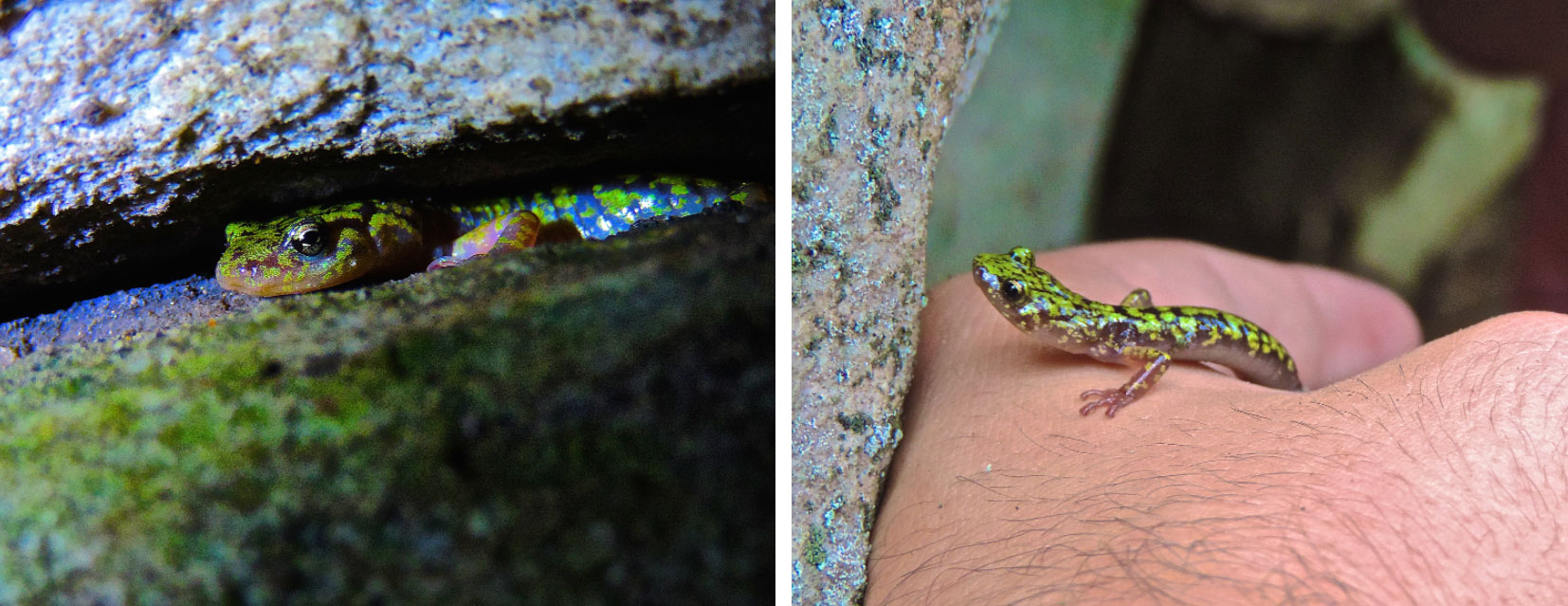Wally's World

Update - January 2023 Jump to the update of Wally Smith's story below.
Southwest Virginia is salamander central. Some 40 species in the Plethodontid family call the southern Appalachians home, making these ancient mountains a global hotspot for the lungless amphibians. These cryptic—or highly secretive—creatures play an important role in the local ecology, and in some areas they are the most abundant vertebrate in the forest.
For a self-professed salamander fan like Wally Smith, associate professor of biology at the University of Virginia’s College at Wise, this level of salamander biodiversity is a researcher’s dream come true. Smith’s primary focus is the green salamander (Aneides aeneus), a species noted for its bright emerald green coloration and unusual habitat preferences—sheltering on cliff faces and, in summer, high in the tree canopy.
"I think what draws me to that species is that it’s very weird among Appalachian salamanders,” Smith said. “It is a rock outcrop specialist, so it’s living in vertical cracks and crevices in cliffs. When you’re hunting salamanders you're flipping over logs or rocks on the forest floor or in a stream, and with this thing, you’re literally climbing up mountains and getting to a cliff where you’re taking a headlamp or flashlight and staring into these tiny crevices and seeing these little eyes staring back out. The different nature of the species is part of the allure. It’s a very different way to survey for amphibians in this part of the world."
That’s the thing about green salamanders: they’re hard to find. Consequently, we know little about their life history or distribution. Smith’s research, using a combination of citizen science initiatives and traditional field surveys by UVA Wise students, has led to the discovery of more than 90 previously unknown populations, suggesting the possibility that distribution of A. aeneus in Virginia has been greatly underestimated.
“We really do not know much about the animals, whether it’s the natural history or conservation status,” Smith said. “That’s where all of our research has come from, trying to fill some gaps in knowledge that can help decision-makers, policy-makers, and biologists with state and federal agencies to better manage their land and their resources. I think for me the most surprising thing is that the species, locally at least, is not nearly as rare as we had previously thought. That’s very promising from a conservation perspective.”

Crevice Critters: Green salamanders prefer to live on rock outcrops, cliffs, and, occasionally, in trees. This unusual habitat preference makes them difficult to find.
Smith gravitated toward UVA Wise in part because of its location in the heart of salamander country and in part because of the chance to work with undergraduates, many of whom are first-generation college students. “That’s really what drew me here,” he said. “I knew I wanted to go to a teaching-oriented environment. We have very enthusiastic students and an administration supportive of research. From the scientific perspective, having students we can dedicate to our project has been great. Our students almost act more like grad students.”
Smith’s next project involves working with the U.S. Forest Service. “We’re going to be doing some species surveys on High Knob and in the Jefferson National Forest looking for green salamanders in an area where the Forest Service may be doing some future management activities,” he said. “It’s a great experience for our students. One of the things I love about working at UVA Wise is that we have one-on-one attention with students. I can take students into the field, and they’re not just learning about research techniques—they’re actively engaging in a project with a federal agency. They’re going to do real on-the-ground science that’s going to have a real impact. I’m really excited about that.”
UPDATE - JANUARY 2023
Wally’s World Expands
We checked in with researcher Wally Smith to learn how his world continues to expand. Research that Smith, associate professor of biology at the University of Virginia’s College at Wise, is pursuing with students means that green salamanders (Aneides aeneus) are now a lot easier to find.
As part of a recent collaboration with the U.S. Forest Service, Smith and his students completed their surveys of the salamanders’ habitat and turned that project into a new wildlife survey methodology using remote sensing technology to screen for habitat in rock formations where the highly specialized amphibians live. That methodology was published in June 2022 in the Journal of Fish and Wildlife Management and is assisting researchers and agency biologists with improving surveys for that species.
But Smith and his students didn’t stop there. They also have been working to translate their research into policy recommendations for local governments and other decisionmakers across central Appalachia.
Thanks to a recent grant from the Virginia Environmental Endowment, Smith and students took the lead in bringing together a collaborative team of more than 10 regional organizations to develop an evidence-based blueprint for sustainable growth in Southwest Virginia’s tourism and outdoor economy.
“The effort grew out of an awareness that outdoor development projects were beginning to impact the region’s rare wildlife and natural resources in negative ways. We worked to blend findings from the scientific literature with community and environmental justice concerns into recommendations for policymakers and regional officials,” Smith said.
The resulting blueprint was published as a book in spring 2022, with an accompanying public outreach campaign that included videos and print/digital deliverables promoting the initiative. A full set of resources is available.
Smith intends for the materials to be “living documents” that will adapt and change over time.
“We can do academic research at UVA Wise, gather other regional research, and translate it into meaningful action to help the community and economic development efforts in Southwest Virginia,” he said.
His hope is the work will build the foundation for a lasting model, not only for Appalachia, but beyond.

Rising Star
In 2016, Smith won the Rising Star award from the State Council of Higher Education for Virginia. The award is given to faculty members who show extraordinary promise early in their teaching careers and is based on performance in teaching, discovery, and the integration of knowledge and service. Smith remains one of the college’s most popular professors with his novel, nationally recognized approaches to integrating traditional undergraduate courses with biological research and community outreach.
As a result of Smith’s research, the city of Norton, near the UVA Wise campus, passed a resolution to designate the city’s Flag Rock Recreation Area a green salamander sanctuary in order to protect the animals’ habitat.
Honor the Future: The Campaign for UVA Wise
The University of Virginia’s College at Wise unveiled an ambitious plan to raise $100 million after launching the UVA Wise Honor the Future Campaign on Saturday, October 26 before hundreds of the College’s benefactors, friends, and alumni. Two of the campaign’s goals are to inspire experiential learning and to empower outstanding professors. For more information, visit uvawise.edu/campaign.

